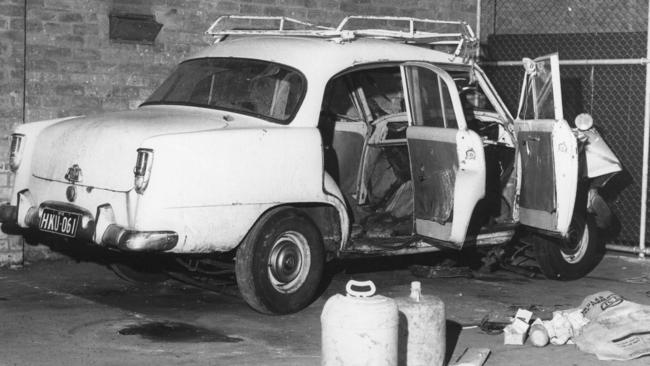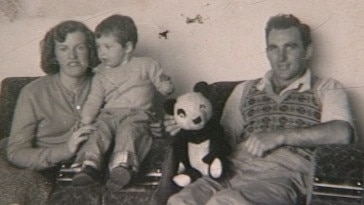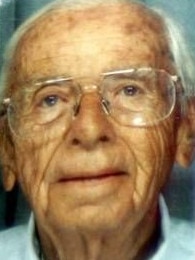Twisted tale of elusive family annihilator Elmer Crawford
Elmer Crawford eerily asked his father-in-law if he believed in the afterlife a week before he annihilated his family – and got away with it.

Police & Courts
Don't miss out on the headlines from Police & Courts. Followed categories will be added to My News.
Are you still hiding out there, Elmer Kyle Crawford? You’d be 92 now, nearly 93, a little old man with a secret so terrible it would kill a normal person. Not that you were ever really normal.
If you’re still alive, your hair will be grey or gone, your face wrinkled by 70 Australian summers. But some things don’t change – you were short, with a hawkish nose and face, and never lost the Irish brogue you brought from Derry as a young man in 1951.
You were a loner, quiet and secretive, unknowable even to those who worked with you for years on the maintenance team at Flemington Racecourse, where you were a jack-of-all-trades, handy “on the tools” but light-fingered to a fault.


A cunning thief but also a compulsive hoarder, taking not just things you could sell but things you couldn’t. Dishonesty was the least of it. You were greedy, miserly and strange.
No-one except you knows why you annihilated your family. Probably only your wife Theresa had any idea, and if she did, the truth died with her the night you hit her with a lead-lined cosh you made to do exactly that, then electrocuted her with the device you fabricated to connect alligator clips to mains power. That was before you smashed your three children with a hammer.
What also died the moment you sent the deadly current through Theresa’s body was the unborn baby inside her. The baby you didn’t want, the baby you’d told her not to have. She was trapped between her strict religious faith and your twisted personality, formed in the bleak place where you’d been brought up by grandparents after your young mother abandoned the illegitimate baby that grew into you.
Your mother bolted to North America and married there and raised a daughter. She left you forever, and you never met her or forgave her. Perhaps that’s what turned you into a monster behind the mask you held up to the world.
Or was it because of what happened to a “poor little bastard” in the savage sectarian schools of Northern Ireland in the 1940s? A case of the more cruelly you were treated, the more callous you became?

The week before he murdered his family, Elmer Crawford was cleaning up the backyard of the family’s brick veneer in Cardinal Rd, Glenroy, with his father-in-law, Jim McManus, who was visiting from Queensland.
For no apparent reason, Crawford suddenly said to the grandfather of his children: “Jim, do you believe in the afterlife?”
McManus, staunch Catholic and father of 10, said he certainly did. They resumed work silently but Crawford’s strange question would soon return to haunt McManus.
Days later, on the evening of July 1, 1970, a Wednesday, Crawford killed his wife with the device he’d carefully made in his well-equipped tool shed. Then he killed their children: 13-year-old Katherine, six-year-old Karen, and James, who was eight.
It was no spur of the moment thing. No flash of anger. He’d been planning it for weeks. He was, in fact, due back at work in his job at Flemington that day but he did not go, a strange thing for a man so punctual.

Instead, he had been busy at home, toiling late in his backyard workshop to a deadline only he knew about. In truth, he had no intention of returning to his job.
Two women visitors to the Crawford house the previous day, Tuesday, June 30, had seen Crawford working on his car, a late 1950s Holden sedan.
One of the visitors noticed the car’s boot was open and she could see right through the vehicle from the back to the front windscreen.
It took her a moment to realise that the back seat and dividing panel were missing. It was as strange as Crawford’s cold response when she greeted him.
Next day, July 1, one of Crawford’s workmates came to the house twice to see why the Irishman wasn’t at work. The workmate didn’t see him on either visit, as if Crawford had hidden.
Also that day, Avon saleswoman June Watson dropped in to see Theresa at mid-morning, as she did every few weeks. But whereas Theresa was usually up for a chat and a chance to browse the Avon cleaning catalogue, this time she was curt and unfriendly.
The Crawfords’ youngest child, Karen, was hiding behind her mother’s legs, looking miserable. Theresa said Karen had been awake for two nights with a toothache.
Watson was probably the last person outside the family to see Theresa and Karen alive.


Next day, Thursday, David and Ellen Henry were visiting Loch Ard Gorge in the Port Campbell National Park, hoping to see the famous blowhole in action.
The couple arrived after lunch and walked to the cliff edge, in those days protected only by a ditch designed to stop vehicles getting too close to the dizzy drop into the sea.
Ellen noticed fresh tyre marks on the strip of land between the road and the cliff edge. Horrified, she saw that the tracks went right to the edge. She called her husband and they crept towards the edge to look down.
On a narrow cliff ledge below they saw a smashed car, balanced so its open driver’s door dangled over the ocean. It looked as though one big wave would pull it into the sea. They noted the registration number and drove to Port Campbell to find the police.
It was a policeman who noticed that the tyre marks led back to the spot where the car had crossed the protective ditch. It was obvious someone had recently piled rocks into the ditch so a car could cross it. This was no accident.
A volunteer rescue climber went down the cliff on ropes. He could see the back of the car had blankets, a tarpaulin and empty containers. Also a black hose leading from the exhaust towards the driver’s door, as if set up by someone intent on suicide by carbon monoxide.

Back in Glenroy, one of Katherine Crawford’s school friends had knocked on the door at Cardinal Rd to ask if her classmate was coming to school. Elmer Crawford gruffly told her Katherine was sick.
Later, Crawford was in the driveway when two locals, Barb and Len Smith, drove past and saw him. So a total of three witnesses saw him at the house that day before the Broadmeadows police came calling.
A constable knocked on the door of the darkened house around 6pm. No answer. At 10.15pm the constable returned with a detective, meaning police were now deeply concerned by the family car at Loch Ard Gorge.

The two policemen went around the back. The first thing they saw was Crawford’s motor scooter.
When they broke into the house, the police found blood in three rooms. They also found a bottle of upholstery cleaner that was still foamy, as if it had been shaken and used recently. It matched wet marks in the hall where bloodstains had been swabbed. It looked as if someone had been interrupted cleaning the scene.
But until the police recovered the car they couldn’t be certain their suspicions were right.
Next morning, rescue workers shackled the car ready to winch it up the cliff. Only then could they safely open its doors.

Under the tarpaulin in the back were four bodies: Theresa and her children.
At first, police wondered if Crawford had been murdered, too, by an unknown third party. But it soon became clear that the missing husband and father was the most likely killer.
If the car had not lodged on the ledge and had dropped into deep water as Crawford had planned, there would have been no evidence of a crime, giving him plenty of time to spread a cover story that Theresa had taken the kids to Queensland for a holiday while he took his time to stage his own disappearance.
But the almost instant discovery of the car meant Crawford had to make his escape in a hurry, alerted when the police came knocking. Despite the rush, he still managed to vanish without leaving any clues, although he could now never sell the blocks of land he owned in Queensland.

In 1994, a woman visiting Bunbury, Western Australia, swore blind that she’d seen Crawford at a local hotel. She was the wife of a scrap dealer who used to buy copper wire from the strange little Irishman back in Melbourne. She approached the man, who told her he was visiting from New Zealand, but she did not tell police until she got back to Victoria two weeks later. Police found no trace of the Bunbury man, but later came to believe the sighting was probably genuine.
Later, an apparently promising development came to nothing when DNA tests apparently ruled out a mysterious man who’d died in Texas. He was the right age to be Crawford, his fingerprints were so damaged as to be useless, and he carried false identity documents under several names.
Almost everyone except those who knew and loved Theresa Crawford and her three children gradually forgot the case. But a boy who grew up in the same street in Glenroy never did.
His name is Greg Fogarty and he has been fascinated by the Crawford case all his life.
In 2005, he published a book about it. He called it Almost Perfect. It’s the perfect title for the story of a man who got away with murder.





